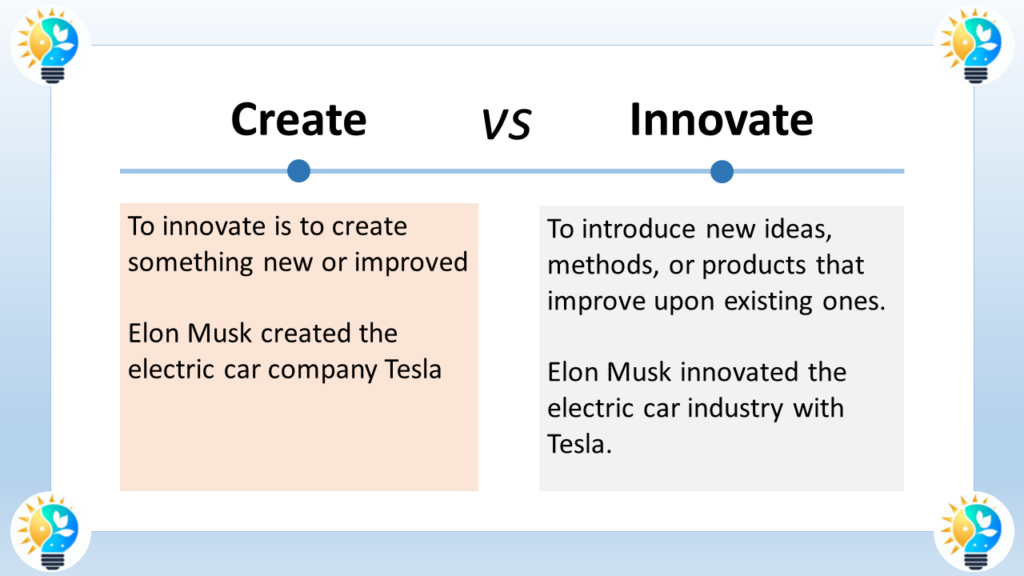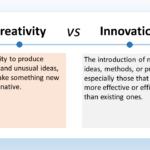
Creativity and innovation are two concepts often used interchangeably.
Creativity serves as a fundamental aspect of both innovation and development.
Creativity fosters the generation of new ideas or approaches, contributing to the innovation process.
Innovation fuels the creation of novel solutions or methods, and supports development by inspiring continuous improvement or evolution in various endeavors
They represent distinct yet intimately connected facets of business development and progress.
Defining Creativity and Innovation
Before we delve into their intricate relationship, it’s vital to establish clear definitions for both creativity and innovation:
Creativity
Creativity is the process of generating novel, unique, and valuable ideas. It involves breaking free from conventional thinking patterns, exploring uncharted territory, and harnessing one’s imagination to envision possibilities.
Innovation
Innovation, is the practical application of creative ideas to produce tangible, valuable outcomes. It involves transforming these novel concepts into real-world products, services, or processes that address specific needs or challenges.
More Synonyms on innovation, innovate and innovative
Innovation Terms

Innovation is considered as a driving force in progress.
It includes the introduction of novel ideas, methods, or products that bring positive change and advancement.
For more information about innovations, check our glossary
Creativity Initiates, Innovation Implements
The connection between creativity and innovation is akin to a relay race.
Creativity serves as the starting point, the spark that ignites the innovation process. Entrepreneurs who nurture their creative thinking are better equipped to identify opportunities, envision solutions, and conceive groundbreaking concepts.
While creativity is an important component of innovation, it is not enough on its own. Innovation requires a focus on implementation and value creation. Similarly, while technical expertise is important for innovation, it is not sufficient without creative thinking.

In short, creativity is the generation of new ideas, while innovation is the implementation of those ideas to create value.
Innovation Fulfills Creative Potential
While creativity instigates the process, innovation is the realization of creative potential. It's about taking those imaginative ideas and breathing life into them. Innovators devise strategies, allocate resources, and surmount obstacles to bring these ideas into the real world. In essence, without creativity, there would be no innovative projects to embark upon.
Innovation Defined: Exploring the Essence of Creative Progress
Defining Create and Innovate
Creating is the act of producing something new, while innovating involves improving upon existing ideas. Innovating often involves creating something new, but it also involves making existing ideas better.

Creativity and innovation are nouns that describe the ability to generate new ideas and turn them into practical applications. The verbs associated with these concepts are "create" and "innovate."
To create means to bring something new into existence, to produce or make something original. In a creative context, "create" often refers to the process of generating new ideas, concepts, or works of art. For example, an artist may create a painting, a writer may create a novel, or a scientist may create a new theory.
To innovate means to introduce something new or make changes to existing products, processes, or services in order to improve their effectiveness or value. In a business context, "innovate" often refers to the process of developing and implementing new ideas to create competitive advantage. For example, a company may innovate by developing a new product, improving a manufacturing process, or introducing a new marketing strategy.
Defining Creative and Innovative
Creative and innovative are adjectives that describe the qualities of being creative and innovative, respectively.
Creative is an adjective that describes something or someone that has the ability to generate new ideas, concepts, or works of art. A creative person is one who is able to think outside the box, come up with original solutions to problems, and express themselves in unique and imaginative ways. Examples of creative pursuits include writing, painting, music, dance, and design.
Innovative is an adjective that describes something or someone that introduces new ideas, methods, or products. An innovative person is one who is able to think creatively and practically, and who is willing to take risks to bring new ideas to life. Innovative companies are those that are constantly seeking to improve their products, services, and processes in order to stay ahead of the competition.
In summary, creative describes the ability to generate new ideas, while innovative describes the ability to turn those ideas into practical applications. Both are valuable qualities in many fields, and they often go hand in hand.
Innovative Terms

Innovation is considered as a driving force in progress.
It includes the introduction of novel ideas, methods, or products that bring positive change and advancement.
For more information about innovations, check our glossary
Broadening on Creativity and Innovation
Creativity and innovation are closely related but distinct concepts that play crucial roles in business success and progress. Here's an overview of how they are connected:
Key Relationships
- Creativity as a Precursor: Creativity is often the starting point for innovation. Without creative ideas, there would be nothing novel to innovate[3].
- Complementary Processes: While creativity is about generating ideas, innovation focuses on implementing those ideas practically[4].
- Interdependence: Innovation cannot exist without creativity, but creativity can exist without resulting in innovation[3].
- Stages of Development: Creativity represents the ideation stage, while innovation encompasses the entire process from idea generation to implementation[2].
Business Impact
In a business context, both creativity and innovation are vital:
- Creativity fuels the generation of unique ideas and solutions to problems.
- Innovation turns those ideas into marketable products or services that provide value to customers and the company[1].
Successful companies like Apple demonstrate this relationship well. Steve Jobs was creative in envisioning new product ideas, while Apple as a company was innovative in turning those ideas into groundbreaking products like the iPhone[1].
Fostering Creativity and Innovation
To thrive, organizations need to:
- Nurture a culture that encourages creative thinking
- Develop processes to transform creative ideas into innovations
- Balance both aspects to drive continuous improvement and growth[1][2]
By understanding and leveraging the relationship between creativity and innovation, businesses can enhance their competitive edge and drive meaningful progress in their industries.
Problem Solving: The Common Thread
One of the key elements that tightly binds creativity and innovation is problem-solving. Entrepreneurs often encounter complex challenges in their journeys, and creative thinking provides a route to navigate through them. Creative problem-solving leads to innovative solutions that distinguish businesses in competitive markets.
Unleashing Creativity: How Technology Fuels Innovation in the Digital Age
Embracing Risk for Reward
Innovation often involves venturing into uncharted territory, and this inherently requires risk-taking. Entrepreneurs must be willing to take calculated risks to bring their creative ideas to fruition. This risk-taking mentality is closely connected to the creative process, as it necessitates the courage to explore unconventional approaches.
Collaboration Breeds Excellence
Collaboration is another essential element that bridges the gap between creativity and innovation. Entrepreneurs rarely work in isolation; they rely on diverse teams to refine and implement their creative ideas. Creative brainstorming sessions and cross-functional collaborations are fertile grounds for nurturing innovative concepts.
Continuous Evolution
Creativity and innovation are not isolated events but ongoing processes. Successful entrepreneurs understand that creativity should be nurtured continuously, and innovation should be an unceasing pursuit. This iterative approach keeps businesses agile and competitive in a rapidly changing world.
Adaptability in a Changing Landscape
In today's fast-evolving business environment, adaptability is paramount. Creative thinking enables entrepreneurs to adjust their products, services, and strategies in response to shifting market dynamics. This adaptability is a fundamental driver of innovation.
The Tech Catalyst
Technology plays a pivotal role in both creativity and innovation. Entrepreneurs can leverage digital tools and platforms to enhance their creative processes and streamline innovative endeavors. This synergy between technology and creativity accelerates the pace of innovation, enabling businesses to stay ahead of the curve.
Measuring Success Through Innovation
The success of entrepreneurship is often measured by the extent of innovation achieved. Creative ideas that translate into innovative products or services can lead to market disruption and business growth. Tracking key performance indicators related to innovation is essential for evaluating entrepreneurial success.
Example of creativity
Creativity is the ability to generate new and unique ideas, concepts, or solutions. It involves thinking outside the box and coming up with innovative approaches to problems or challenges.
SmartPhone
An example of creativity in the context of innovation could be the development of the first smartphone. Before smartphones existed, people used separate devices for making calls, sending messages, listening to music, and accessing the internet. However, someone with a creative mindset came up with the idea of combining all these functionalities into a single device. This innovative approach revolutionized the way we communicate and access information, leading to a whole new industry and countless advancements in technology.
Animated quotes on creativity
TO NOTE:
- Creativity is the inception, while innovation is the realization.
- Problem-solving, risk-taking, collaboration, and adaptability are key elements connecting creativity and innovation.
- Technology is a powerful enabler of both creative processes and innovation efforts.
In summary, the relationship between creativity and innovation in entrepreneurship is not just a simple connection; it's a dynamic partnership that propels businesses forward. Creativity fuels the initial spark, and innovation breathes life into creative ideas. Successful entrepreneurs recognize the importance of nurturing creativity, embracing calculated risks, and fostering a culture of innovation. In a world of constant change, this dynamic duo is the key to staying competitive and making a lasting impact.
References:
- Stanford Online - Creativity and Innovation Management
- ScienceDirect - Creativity and Innovation in Entrepreneurship
- The Relationship Between Creativity and Innovation
- Creativity and Innovation
- How Are Creativity and Innovation Related?
- Creativity vs. Innovation: What's the Difference?
- The Association Between Creativity and Innovation: A Literature Review

